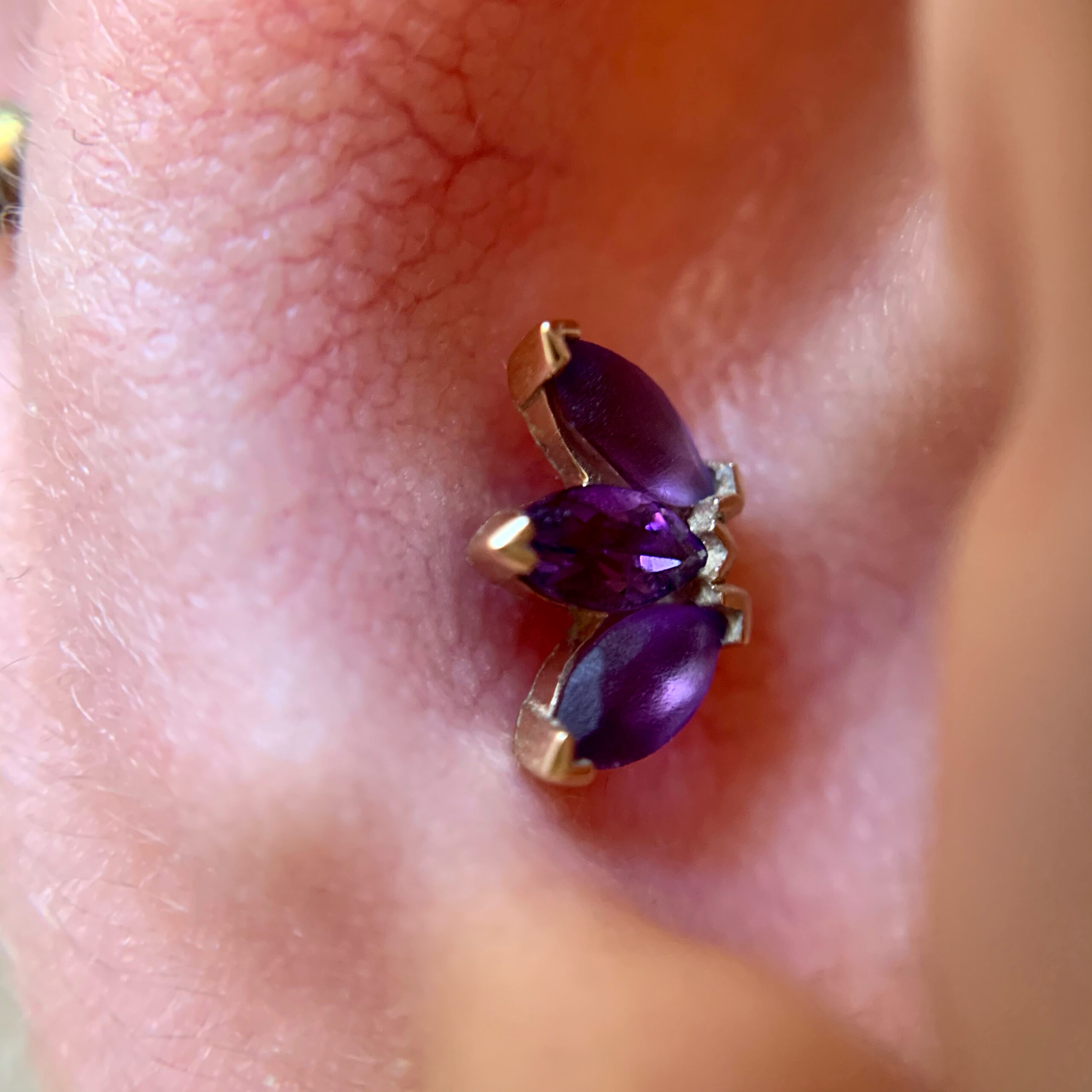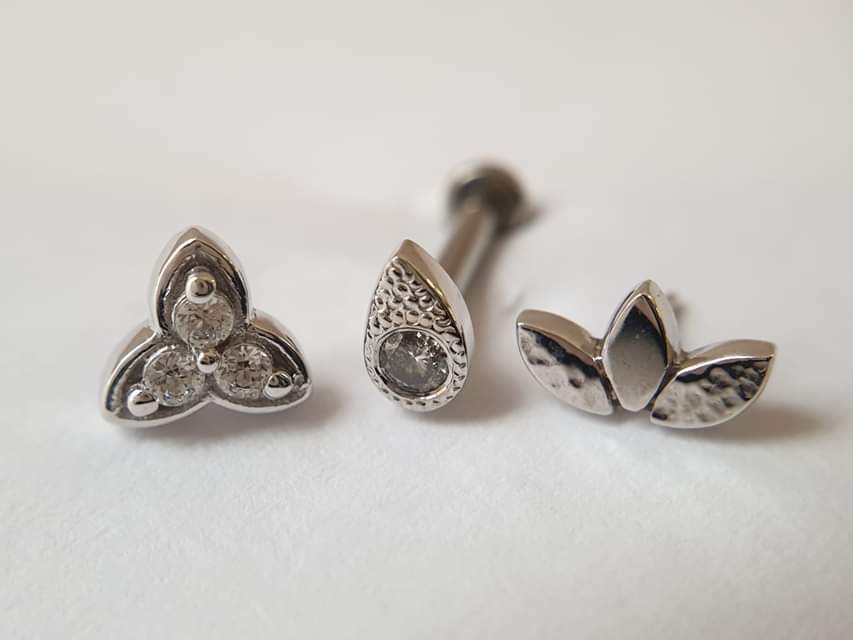
As piercing grows and rises in popularity, the number of piercers and jewellery companies has exploded. Fortunately, the amount of education and information available on piercings and jewellery is also growing. However as clients become more aware of quality and what to look for, bad jewellery companies and piercers have become wise to this and are beginning to twist the truth in order to continue to sell their poorly made jewellery. By using certain key words, some jewellery sellers are able to mislead their customers into purchasing low quality jewellery.
Here we will discuss what to look for in quality jewellery, and what to avoid when purchasing your own jewellery. We stock only the best in body jewellery, and you can shop these options here!
Metals
The first thing to discuss is what your jewellery is made of. The most common material is metal as it is durable, comfortable and easily available. However, not all metals are made equal.
Steel
Steel is not a single material, but an umbrella term for potentially thousands of different alloys. Only one grade of steel is implant grade and that is ASTM F-138 grade steel. However, the vast majority of steels used in piercing are ‘stainless steel’ and ‘surgical steel.’ Neither of these have any formal definition or safety status, and usually contain nickel and other allergens. One grade of ‘surgical steel’ that is often marketed as body safe is 316L. If you read into 316L, it is actually a low grade of marine steel. This is steel intended for use in heavy machinery, wastewater piping, and the petrochemical industry- not in the human body! These are pretty much the definition of mystery metals! We do not sell steel jewellery because of this. ASTM F-138 steel jewellery from one of our trusted brands can be ordered by request.
Titanium

Titanium jewellery is often considered the ‘gold standard’ (no pun intended) of body jewellery, but even titanium has its faults. There are 6 grades of pure Titanium, and multiple alloys. All of these can be marketed to the client as Titanium jewellery. Only one grade is commonly used in body piercing and is also implant grade: ASTM F-136 Titanium. Even this can be misleading! Some brands market themselves as selling ASTM F-136 Titanium jewellery, and yet when they are asked to produce mill certificates to prove this they either cannot provide them, or choose not to, or their certification comes from a source that has been exposed as falsifying documentation in the past. Every single brand we sell at Rogue can produce their ASTM F-136 certification from a trusted source.
Gold
Gold has been successfully used in body jewellery for millenia. Before brick buildings and agriculture, there was Gold jewellery. However, it is important to understand the carat system of Gold. Pure Gold, 100% solid Gold, is 24ct. This means it is 24/24 parts Gold. The three main carats are 9ct, 14ct and 18ct. Let’s do the maths on these. 18k Gold is 18/24 or 75% pure Gold. 14k is 14/24 or 59% Gold. 9k Gold is 9/24 or 37% Gold. The rest of the alloy is what is important- If your 9ct Gold is only 37% Gold, then it begs the question of what the other 63% is? We only use body-safe 14k or 18k Gold alloyed with other high-quality, nickel-free metals which has been proven safe to wear long term. No high-end body jewellery company manufactures 9ct jewellery. The filler metals in 9ct Gold tend to be low-quality metals such as nickel and copper, which could be causes of irritation in piercings. Gold plating or vermeil is a whole other topic which is discussed below. We are incredibly proud of the Gold options we sell, and we hope you appreciate the time and effort that goes into producing and stocking only the best items for you.
Coatings
Some jewellery is available with a coating. This could be ‘Gold plating,’ ‘PVD Gold,’ ‘Titanium dipped,’ ‘Black PVD,’ or any other marketing term from a list of hundreds. None of these items are body safe or suitable for long term wear. These items generally don’t mention what material is used under the coating, so once the coating wears down or chips off (which it will!) you are exposing yourself to a mystery metal. Not only this, but the chipped surface is a perfect breeding ground for bacteria, and can scratch you to cause irritation.
Gold Vermeil is a new marketing term we have seen in the last few years. Vermeil is a layer of Gold plated onto Sterling silver, which is not body safe. So again, once the coating wears away you are left exposed to an unsafe metal. For this reason, we do not stock plated or coated jewellery. If you would like fun coloured jewellery, we can anodise your Titanium jewellery by passing an electrical current through it to change the colour that the metal reflects! This is the only body-safe way to wear coloured jewellery. If you want Gold jewellery, the only way to safely do so is to purchase solid Gold jewellery.
To read about more materials and their merits (or issues), click here.
Threading

There are two main types of threading: Internal threading (which includes threadless) and external threading. This is often the first port of call when investigating whether your jewellery is high quality. Externally threaded jewellery is when the thread pattern is exposed on the labret or barbell. There is currently no high-quality brand in the world that produces externally threaded jewellery. This is because the thread will tear the fistula every time it is inserted or removed, which in turn will irritate your piercing and increase your risk of infection as you are removing the dermal barrier. Externally threaded jewellery is not made in body-safe materials such as ASTM F-136 Titanium or 18k body-safe Gold. Why do some studios still use external thread? It is simply down to cost. Externally threaded jewellery is often up to 50% cheaper to buy than internally threaded jewellery.
Not only is internally threaded jewellery safer to insert and remove, but it is also a much more secure threading style than external thread. If you find that you consistently lose your ends from an externally threaded labret, then maybe it’s time to move to internally threaded jewellery. Our high end manufacturers pride themselves on producing only the most secure threaded jewellery!
Jewellery Polish

One thing that is often overlooked when purchasing body jewellery is the surface finish of your jewellery. All jewellery should be free of scratches, nicks and dents. It should have an utterly perfect mirror finish – In our jewellery photos you can often see our reflection in the piece!
Scratches, knicks and dents can irritate your piercing in the same way as external threading does. Not only this, but any imperfections in surface finish gives bacteria a place to grow and multiply which is not good for a fresh or healed piercing. Some studios have been known to save money by purchasing and using totally unpolished jewellery. Our jewellery is either hand-polished or goes through a multi-stage mechanical polishing process in order to produce that incredibly reflective and smooth finish.
Conclusion
In order to be a high-quality piece of jewellery, your item must be at the highest standards of each of these categories- You can find and purchase low-quality, poorly polished internally threaded jewellery. You can also buy Titanium that has been dipped in a plastic or painted coating, rendering it dangerous. The gold standard of body jewellery is an internally threaded or threadless item made from ASTM F-136 certified Titanium or body-safe 14/18k Gold that has been polished to a superb mirror finish.
Where you purchase jewellery from is also incredibly important. We do not recommend purchasing jewellery from online retailers that do not have a physical piercing studio. Handmade options from websites such as Etsy may look cute and be a unique choice, but they have no safety regulations and sellers often cannot produce documentation to prove their jewellery is safe. Some are even just resellers for companies or brands that are known to produce dangerously low quality jewellery.
The best way to guarantee the safety and quality of your jewellery is to purchase your items from a well-known, high quality brand such as BVLA, Neometal, Industrial Strength, Anatometal or LeRoi through your local premium piercer. If you want to see our range of these brands, click here. Our basic range also meets these high standards, and we are proud to carry safe jewellery that is accessible to all budgets.
This is just an overview of what to look for in quality, safe jewellery that will last a lifetime. The brands we carry offer a lifetime warranty, so you can imagine the pride and care they take in offering only the highest quality jewellery. If you have any questions about jewellery or the quality of what we carry, don’t hesitate to get in touch via kat@roguepiercing.co.uk or via our instagram.




































